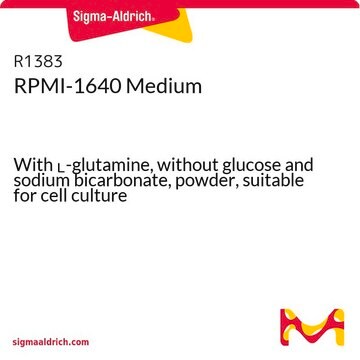D5030
Dulbecco′s Modified Eagle′s Medium
Without glucose, L-glutamine, phenol red, sodium pyruvate and sodium bicarbonate, powder, suitable for cell culture
Synonym(s):
DME, DMEM
About This Item
Recommended Products
Quality Level
form
powder
technique(s)
cell culture | mammalian: suitable
components
phenol red: no
NaHCO3: no
L-glutamine: no
HEPES: no
glucose: no
sodium pyruvate: no
shipped in
ambient
storage temp.
2-8°C
General description
Application
- to culture the isolated flexor digitorum brevis (FDB) fibers to measure exogenous fatty acid (FA) utilization as part of oxygen consumption rate (OCR) measurements
- to culture the isolated tibialis anterior (TA) muscle fibers for lactate measurements
- to culture the human bone marrow mesenchymal stem cells for osteogenic differentiation to prepare a low-glucose medium to culture human hepatocellular carcinoma HepG2 cells
Quantity
Reconstitution
also commonly purchased with this product
related product
supplement
Signal Word
Warning
Hazard Statements
Precautionary Statements
Hazard Classifications
Eye Irrit. 2
Storage Class Code
11 - Combustible Solids
WGK
WGK 3
Flash Point(F)
Not applicable
Flash Point(C)
Not applicable
Certificates of Analysis (COA)
Search for Certificates of Analysis (COA) by entering the products Lot/Batch Number. Lot and Batch Numbers can be found on a product’s label following the words ‘Lot’ or ‘Batch’.
Already Own This Product?
Find documentation for the products that you have recently purchased in the Document Library.
Customers Also Viewed
Articles
Calcium is an ionically stable divalent cation with important beneficial and toxic properties in cell culture. It is a component of a wide range of cell culture media.
Protocols
Cultrex® Basement Membrane Extract (BME) is a soluble form of basement membrane purified from Engelbreth-Holm-Swarm (EHS) tumor.
3-D Culture Matrix™ Mouse Laminin I may be used as a gel or as a media additive to study cellular growth and differentiation in three dimensions in vitro.
Powdered media and salt mixtures are extremely hygroscopic and should be protected from atmospheric moisture.
Related Content
Our broad range of the most trusted tools for cell culture includes stringently sourced and tested FBS, established media formulations, and sterile labware. Cutting-edge techniques using stem cells and 3D matrices are enabled by organoids, hydrogels, culture scaffolds, and bioinks for 3D bioprinting.
Our team of scientists has experience in all areas of research including Life Science, Material Science, Chemical Synthesis, Chromatography, Analytical and many others.
Contact Technical Service







